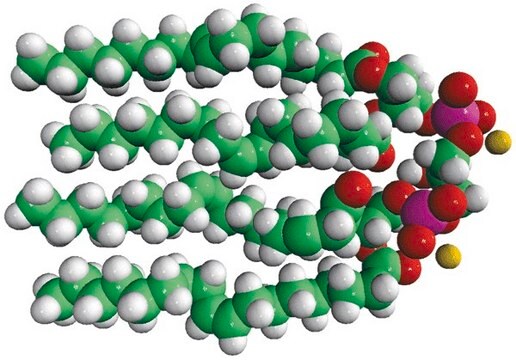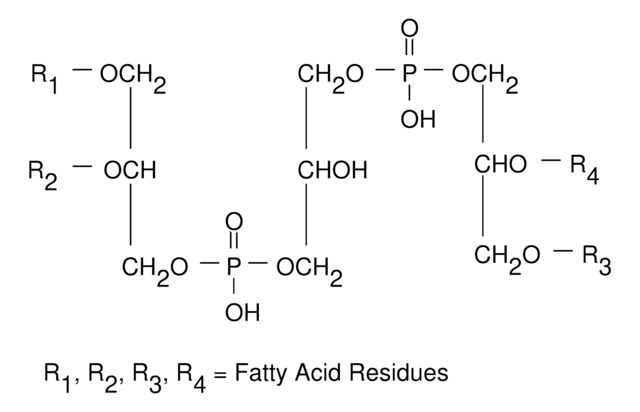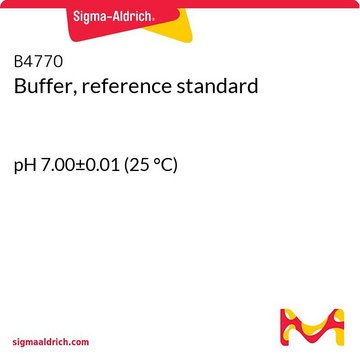C1649
Cardiolipin solution from bovine heart
4.7-5.3 mg/mL in ethanol, ≥97% (TLC)
Sinônimo(s):
Diphosphatidylglycerol solution
Faça loginpara ver os preços organizacionais e de contrato
About This Item
Produtos recomendados
fonte biológica
bovine heart
Ensaio
≥97% (TLC)
Formulário
liquid
embalagem
glass bottle of
concentração
4.7-5.3 mg/mL in ethanol
cor
colorless to yellow
aplicação(ões)
general analytical
lipidomics
metabolomics
grupo funcional
phospholipid
tipo de lipídio
phosphoglycerides
Condições de expedição
dry ice
temperatura de armazenamento
−20°C
Procurando produtos similares? Visita Guia de comparação de produtos
Categorias relacionadas
Descrição geral
Cardiolipin (CL) is a complex lipid with a dimeric structure. It has four acyl chains and two phosphatidyl moieties. Its phosphatidyl moieties are linked to the glycerol backbone. Around 15-20 percent of the inner mitochondrial membrane accounts for cardiolipin.
Cardiolipin is a unique phospholipid found exclusively within the mitochondrial inner membrane. This specific localization allows Cardiolipin to exert crucial influence on mitochondrial structure and function. Deviations in Cardiolipin content, structure, or localization can lead to impaired mitochondrial activity, contributing to various diseases like cancer, neurological disorders, cardiovascular conditions, and metabolic diseases. As Cardiolipin plays a crucial role in mitochondrial function, it holds immense potential for biomarker development and finds application in cardiovascular, neuroscience, cancer, diabetes, and metabolomics research.
Aplicação
Cardiolipin solution from bovine heart has been used:
- for coating Corning 96-well enzyme immunoassay/radioimmunoassay (EIA/RIA) plate to perform enzyme-linked immunosorbent assay (ELISA)-based cardiolipin binding assay
- in lipid analysis along with phosphatidylglycerol (PG) to comigrate the radiolabeled lipids to identify PG and cardiolipin (CL)
- in coating ELISA plates for antiphospholipid antibodies (aPL) assays
Ações bioquímicas/fisiológicas
Cardiolipin (CL) plays a key role in mitochondrial biogenesis, fusion and fission, respiration, and protein import. It participates in the cellular processes outside of the mitochondria like cell wall biogenesis, aging, vacuole homeostasis, the cell cycle, and apoptosis. CL is also involved in heart function, autophagy/mitophagy, and the protein kinase C (PKC) pathway.
Cardiolipin is a mitochondrial phospholipid that is found in mammalian tissues in low concentrations. It is often a membrane component and can inhibit cell attachment of fibronectin, vitronectin, and type I collagen.
Características e benefícios
- High-quality molecule suitable for mulitple research applications
- Commonly employed in Metabolomics and Biochemical studies
Outras notas
>80% polyunsaturated fatty acid content, primarily linoleic acid.
For additional information on our range of Biochemicals, please complete this form.
forma física
Approximately 5 mg/ml in ethanol.
Palavra indicadora
Danger
Frases de perigo
Declarações de precaução
Classificações de perigo
Eye Irrit. 2 - Flam. Liq. 2
Código de classe de armazenamento
3 - Flammable liquids
Classe de risco de água (WGK)
WGK 2
Ponto de fulgor (°F)
55.4 °F - closed cup
Ponto de fulgor (°C)
13 °C - closed cup
Escolha uma das versões mais recentes:
Já possui este produto?
Encontre a documentação dos produtos que você adquiriu recentemente na biblioteca de documentos.
Os clientes também visualizaram
H A Schenkein et al.
Journal of dental research, 92(9), 814-818 (2013-07-17)
β2-glycoprotein I (β2GPI)-dependent anticardiolipin autoantibodies (aCl) are associated with thrombosis and fetal loss. Some microbial pathogens can induce pathogenic antibodies cross-reactive with β2GPI. Sera from a significant percentage of periodontitis patients contain aCl, and some periodontal pathogens contain antigens with
Hervé Roy et al.
Proceedings of the National Academy of Sciences of the United States of America, 105(12), 4667-4672 (2008-02-29)
Multiple peptide resistance (MprF) virulence factors control cellular permeability to cationic antibiotics by aminoacylating inner membrane lipids. It has been shown previously that one class of MprF can use Lys-tRNA(Lys) to modify phosphatidylglycerol (PG), but the mechanism of recognition and
Michael S Lee et al.
Cells, 9(4) (2020-04-25)
Mantle cell lymphoma (MCL) is an aggressive subtype of non-Hodgkin's lymphoma. Despite being responsive to combination chemotherapy, median survival remains around 5 years due to high rates of relapse. Sphingolipid metabolism regulates MCL survival and proliferation and we found that
Keun Young Hwang et al.
Journal of virology, 90(1), 506-520 (2015-10-30)
Mitochondrial lipid raft-like microdomains, experimentally also termed mitochondrial detergent-resistant membrane fractions (mDRM), play a role as platforms for recruiting signaling molecules involved in antiviral responses such as apoptosis and innate immunity. Viruses can modulate mitochondrial functions for their own survival
Denong Wang et al.
Drug development research, 75(3), 172-188 (2014-03-22)
Using an integrated antigen microarray approach, we observed epitope-spreading of autoantibody responses to a variety of antigenic structures in the cerebrospinal fluid (CSF) of patients with multiple sclerosis (MS) and in the serum of mice with experimental autoimmune encephalomyelitis (EAE).
Nossa equipe de cientistas tem experiência em todas as áreas de pesquisa, incluindo Life Sciences, ciência de materiais, síntese química, cromatografia, química analítica e muitas outras.
Entre em contato com a assistência técnica









